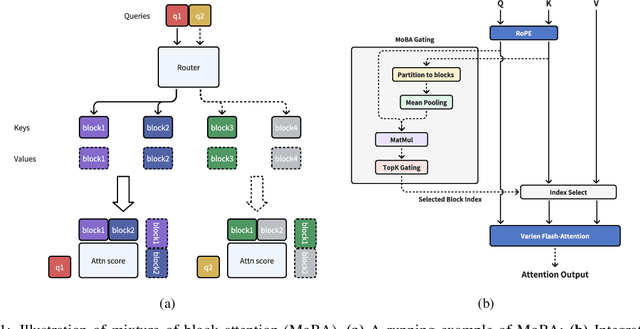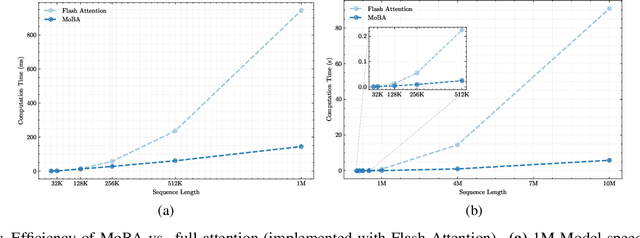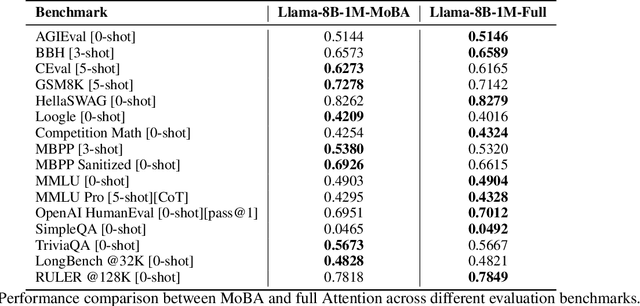Shaowei Liu
Kimi K2: Open Agentic Intelligence
Jul 28, 2025Abstract:We introduce Kimi K2, a Mixture-of-Experts (MoE) large language model with 32 billion activated parameters and 1 trillion total parameters. We propose the MuonClip optimizer, which improves upon Muon with a novel QK-clip technique to address training instability while enjoying the advanced token efficiency of Muon. Based on MuonClip, K2 was pre-trained on 15.5 trillion tokens with zero loss spike. During post-training, K2 undergoes a multi-stage post-training process, highlighted by a large-scale agentic data synthesis pipeline and a joint reinforcement learning (RL) stage, where the model improves its capabilities through interactions with real and synthetic environments. Kimi K2 achieves state-of-the-art performance among open-source non-thinking models, with strengths in agentic capabilities. Notably, K2 obtains 66.1 on Tau2-Bench, 76.5 on ACEBench (En), 65.8 on SWE-Bench Verified, and 47.3 on SWE-Bench Multilingual -- surpassing most open and closed-sourced baselines in non-thinking settings. It also exhibits strong capabilities in coding, mathematics, and reasoning tasks, with a score of 53.7 on LiveCodeBench v6, 49.5 on AIME 2025, 75.1 on GPQA-Diamond, and 27.1 on OJBench, all without extended thinking. These results position Kimi K2 as one of the most capable open-source large language models to date, particularly in software engineering and agentic tasks. We release our base and post-trained model checkpoints to facilitate future research and applications of agentic intelligence.
Kimi-VL Technical Report
Apr 10, 2025Abstract:We present Kimi-VL, an efficient open-source Mixture-of-Experts (MoE) vision-language model (VLM) that offers advanced multimodal reasoning, long-context understanding, and strong agent capabilities - all while activating only 2.8B parameters in its language decoder (Kimi-VL-A3B). Kimi-VL demonstrates strong performance across challenging domains: as a general-purpose VLM, Kimi-VL excels in multi-turn agent tasks (e.g., OSWorld), matching flagship models. Furthermore, it exhibits remarkable capabilities across diverse challenging vision language tasks, including college-level image and video comprehension, OCR, mathematical reasoning, and multi-image understanding. In comparative evaluations, it effectively competes with cutting-edge efficient VLMs such as GPT-4o-mini, Qwen2.5-VL-7B, and Gemma-3-12B-IT, while surpassing GPT-4o in several key domains. Kimi-VL also advances in processing long contexts and perceiving clearly. With a 128K extended context window, Kimi-VL can process diverse long inputs, achieving impressive scores of 64.5 on LongVideoBench and 35.1 on MMLongBench-Doc. Its native-resolution vision encoder, MoonViT, further allows it to see and understand ultra-high-resolution visual inputs, achieving 83.2 on InfoVQA and 34.5 on ScreenSpot-Pro, while maintaining lower computational cost for common tasks. Building upon Kimi-VL, we introduce an advanced long-thinking variant: Kimi-VL-Thinking. Developed through long chain-of-thought (CoT) supervised fine-tuning (SFT) and reinforcement learning (RL), this model exhibits strong long-horizon reasoning capabilities. It achieves scores of 61.7 on MMMU, 36.8 on MathVision, and 71.3 on MathVista while maintaining the compact 2.8B activated LLM parameters, setting a new standard for efficient multimodal thinking models. Code and models are publicly accessible at https://github.com/MoonshotAI/Kimi-VL.
PhysGen3D: Crafting a Miniature Interactive World from a Single Image
Mar 26, 2025Abstract:Envisioning physically plausible outcomes from a single image requires a deep understanding of the world's dynamics. To address this, we introduce PhysGen3D, a novel framework that transforms a single image into an amodal, camera-centric, interactive 3D scene. By combining advanced image-based geometric and semantic understanding with physics-based simulation, PhysGen3D creates an interactive 3D world from a static image, enabling us to "imagine" and simulate future scenarios based on user input. At its core, PhysGen3D estimates 3D shapes, poses, physical and lighting properties of objects, thereby capturing essential physical attributes that drive realistic object interactions. This framework allows users to specify precise initial conditions, such as object speed or material properties, for enhanced control over generated video outcomes. We evaluate PhysGen3D's performance against closed-source state-of-the-art (SOTA) image-to-video models, including Pika, Kling, and Gen-3, showing PhysGen3D's capacity to generate videos with realistic physics while offering greater flexibility and fine-grained control. Our results show that PhysGen3D achieves a unique balance of photorealism, physical plausibility, and user-driven interactivity, opening new possibilities for generating dynamic, physics-grounded video from an image.
Muon is Scalable for LLM Training
Feb 24, 2025Abstract:Recently, the Muon optimizer based on matrix orthogonalization has demonstrated strong results in training small-scale language models, but the scalability to larger models has not been proven. We identify two crucial techniques for scaling up Muon: (1) adding weight decay and (2) carefully adjusting the per-parameter update scale. These techniques allow Muon to work out-of-the-box on large-scale training without the need of hyper-parameter tuning. Scaling law experiments indicate that Muon achieves $\sim\!2\times$ computational efficiency compared to AdamW with compute optimal training. Based on these improvements, we introduce Moonlight, a 3B/16B-parameter Mixture-of-Expert (MoE) model trained with 5.7T tokens using Muon. Our model improves the current Pareto frontier, achieving better performance with much fewer training FLOPs compared to prior models. We open-source our distributed Muon implementation that is memory optimal and communication efficient. We also release the pretrained, instruction-tuned, and intermediate checkpoints to support future research.
MoBA: Mixture of Block Attention for Long-Context LLMs
Feb 18, 2025



Abstract:Scaling the effective context length is essential for advancing large language models (LLMs) toward artificial general intelligence (AGI). However, the quadratic increase in computational complexity inherent in traditional attention mechanisms presents a prohibitive overhead. Existing approaches either impose strongly biased structures, such as sink or window attention which are task-specific, or radically modify the attention mechanism into linear approximations, whose performance in complex reasoning tasks remains inadequately explored. In this work, we propose a solution that adheres to the ``less structure'' principle, allowing the model to determine where to attend autonomously, rather than introducing predefined biases. We introduce Mixture of Block Attention (MoBA), an innovative approach that applies the principles of Mixture of Experts (MoE) to the attention mechanism. This novel architecture demonstrates superior performance on long-context tasks while offering a key advantage: the ability to seamlessly transition between full and sparse attention, enhancing efficiency without the risk of compromising performance. MoBA has already been deployed to support Kimi's long-context requests and demonstrates significant advancements in efficient attention computation for LLMs. Our code is available at https://github.com/MoonshotAI/MoBA.
PhysGen: Rigid-Body Physics-Grounded Image-to-Video Generation
Sep 27, 2024Abstract:We present PhysGen, a novel image-to-video generation method that converts a single image and an input condition (e.g., force and torque applied to an object in the image) to produce a realistic, physically plausible, and temporally consistent video. Our key insight is to integrate model-based physical simulation with a data-driven video generation process, enabling plausible image-space dynamics. At the heart of our system are three core components: (i) an image understanding module that effectively captures the geometry, materials, and physical parameters of the image; (ii) an image-space dynamics simulation model that utilizes rigid-body physics and inferred parameters to simulate realistic behaviors; and (iii) an image-based rendering and refinement module that leverages generative video diffusion to produce realistic video footage featuring the simulated motion. The resulting videos are realistic in both physics and appearance and are even precisely controllable, showcasing superior results over existing data-driven image-to-video generation works through quantitative comparison and comprehensive user study. PhysGen's resulting videos can be used for various downstream applications, such as turning an image into a realistic animation or allowing users to interact with the image and create various dynamics. Project page: https://stevenlsw.github.io/physgen/
Boosting Continuous Emotion Recognition with Self-Pretraining using Masked Autoencoders, Temporal Convolutional Networks, and Transformers
Mar 18, 2024Abstract:Human emotion recognition holds a pivotal role in facilitating seamless human-computer interaction. This paper delineates our methodology in tackling the Valence-Arousal (VA) Estimation Challenge, Expression (Expr) Classification Challenge, and Action Unit (AU) Detection Challenge within the ambit of the 6th Workshop and Competition on Affective Behavior Analysis in-the-wild (ABAW). Our study advocates a novel approach aimed at refining continuous emotion recognition. We achieve this by initially harnessing pre-training with Masked Autoencoders (MAE) on facial datasets, followed by fine-tuning on the aff-wild2 dataset annotated with expression (Expr) labels. The pre-trained model serves as an adept visual feature extractor, thereby enhancing the model's robustness. Furthermore, we bolster the performance of continuous emotion recognition by integrating Temporal Convolutional Network (TCN) modules and Transformer Encoder modules into our framework.
ContactGen: Generative Contact Modeling for Grasp Generation
Oct 05, 2023



Abstract:This paper presents a novel object-centric contact representation ContactGen for hand-object interaction. The ContactGen comprises three components: a contact map indicates the contact location, a part map represents the contact hand part, and a direction map tells the contact direction within each part. Given an input object, we propose a conditional generative model to predict ContactGen and adopt model-based optimization to predict diverse and geometrically feasible grasps. Experimental results demonstrate our method can generate high-fidelity and diverse human grasps for various objects. Project page: https://stevenlsw.github.io/contactgen/
CTR is not Enough: a Novel Reinforcement Learning based Ranking Approach for Optimizing Session Clicks
Aug 27, 2023



Abstract:Ranking is a crucial module using in the recommender system. In particular, the ranking module using in our YoungTao recommendation scenario is to provide an ordered list of items to users, to maximize the click number throughout the recommendation session for each user. However, we found that the traditional ranking method for optimizing Click-Through rate(CTR) cannot address our ranking scenario well, since it completely ignores user leaving, and CTR is the optimization goal for the one-step recommendation. To effectively undertake the purpose of our ranking module, we propose a long-term optimization goal, named as CTE (Click-Through quantity expectation), for explicitly taking the behavior of user leaving into account. Based on CTE, we propose an effective model trained by reinforcement learning. Moreover, we build a simulation environment from offline log data for estimating PBR and CTR. We conduct extensive experiments on offline datasets and an online e-commerce scenario in TaoBao. Experimental results show that our method can boost performance effectively
Building Rearticulable Models for Arbitrary 3D Objects from 4D Point Clouds
Jun 01, 2023Abstract:We build rearticulable models for arbitrary everyday man-made objects containing an arbitrary number of parts that are connected together in arbitrary ways via 1 degree-of-freedom joints. Given point cloud videos of such everyday objects, our method identifies the distinct object parts, what parts are connected to what other parts, and the properties of the joints connecting each part pair. We do this by jointly optimizing the part segmentation, transformation, and kinematics using a novel energy minimization framework. Our inferred animatable models, enables retargeting to novel poses with sparse point correspondences guidance. We test our method on a new articulating robot dataset, and the Sapiens dataset with common daily objects, as well as real-world scans. Experiments show that our method outperforms two leading prior works on various metrics.
 Add to Chrome
Add to Chrome Add to Firefox
Add to Firefox Add to Edge
Add to Edge